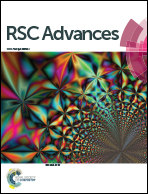A new chiral electrochemical sensor for the enantioselective recognition of naproxen enantiomers using l-cysteine self-assembled over gold nanoparticles on a gold electrode
Abstract
A chiral electrochemical sensor for analyzing the enantiomeric composition of chiral compounds is reported. The method is based on the difference between the interactions of naproxen (Nap) enantiomers with a chiral modified electrode surface. A chiral surface was synthesized on a gold electrode modified with gold nanoparticles and L-cysteine self-assembled monolayers (SAMs). Scanning electron microscopy (SEM), cyclic voltammetry (CV) and electrochemical impedance spectroscopy (EIS) were used to study the enantioselective interaction between the chiral surface and the Nap enantiomers. The results showed that the modified electrode is more stereoselective for S-Nap than for R-Nap. An examination of the characteristics of the chiral interface, including the response time, the effect of enantiomer concentration, and the stability, was performed. Then, the chiral selective interface was used to determine the Nap enantiomers within mixtures by measuring the change in the peak current with different mixture compositions. The results suggested that the proposed chiral biosensor with high sensitivity and selectivity can be used for the recognition of Nap enantiomers.


 Please wait while we load your content...
Please wait while we load your content...